
Kangchenjunga, also spelled Kanchenjunga, Kanchanjanghā and Khangchendzonga, is the third-highest mountain in the world. Its summit lies at 8,586 m (28,169 ft) in a section of the Himalayas, the Kangchenjunga Himal, which is bounded in the west by the Tamur River, in the north by the Lhonak River and Jongsang La, and in the east by the Teesta River. It lies in the border region between Koshi Province of Nepal and Sikkim state of India, with the two peaks West and Kangbachen in Nepal's Taplejung District and the other three peaks Main, Central and South directly on the border.

K2, at 8,611 metres (28,251 ft) above sea level, is the second-highest mountain on Earth, after Mount Everest at 8,849 metres (29,032 ft). It lies in the Karakoram range, partially in the Gilgit-Baltistan region of Pakistan-administered Kashmir and partially in the China-administered Trans-Karakoram Tract in the Taxkorgan Tajik Autonomous County of Xinjiang.

Mountaineering, mountain climbing, or alpinism is a set of outdoor activities that involves ascending mountains. Mountaineering-related activities include traditional outdoor climbing, skiing, and traversing via ferratas that have become sports in their own right. Indoor climbing, sport climbing, and bouldering are also considered variants of mountaineering by some, but are part of a wide group of mountain sports.

Mount Everest(also Mount Sagarmatha or Mount Qomolangma) is Earth's highest mountain above sea level, located in the Mahalangur Himal sub-range of the Himalayas. The China–Nepal border runs across its summit point. Its elevation of 8,848.86 m was most recently established in 2020 by the Chinese and Nepali authorities.

Cho Oyu is the sixth-highest mountain in the world at 8,188 metres (26,864 ft) above sea level. Cho Oyu means "Turquoise Goddess" in Tibetan. The mountain is the westernmost major peak of the Khumbu sub-section of the Mahalangur Himalaya 20 km west of Mount Everest. The mountain stands on the China–Nepal border, between the Tibet Autonomous Region and Koshi Province.

Dhaulagiri, located in Nepal, is the seventh highest mountain in the world at 8,167 metres (26,795 ft) above sea level, and the highest mountain within the borders of a single country. It was first climbed on 13 May 1960 by a Swiss-Austrian-Nepali expedition. Annapurna I is 34 km (21 mi) east of Dhaulagiri. The Kali Gandaki River flows between the two in the Kaligandaki Gorge, said to be the world's deepest. The town of Pokhara is south of the Annapurnas, an important regional center and the gateway for climbers and trekkers visiting both ranges as well as a tourist destination in its own right.
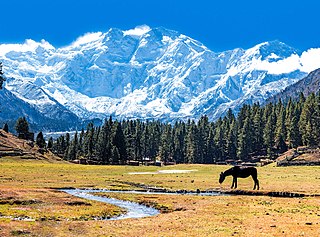
Nanga Parbat, known locally as Diamer, is the ninth-highest mountain on Earth and its summit is at 8,126 m (26,660 ft) above sea level. Lying immediately southeast of the northernmost bend of the Indus River in the Gilgit-Baltistan region of Pakistan-administered Kashmir, Nanga Parbat is the westernmost major peak of the Himalayas, and thus in the traditional view of the Himalayas as bounded by the Indus and Yarlung Tsangpo/Brahmaputra rivers, it is the western anchor of the entire mountain range.

Pumori is a mountain on the Nepal-China border in the Mahalangur section of the Himalayas. Pumori lies just eight kilometres west of Mount Everest. Pumori, meaning "the Mountain Daughter" in Sherpa language, was named by George Mallory. "Pumo" means young girl or daughter and "Ri" means mountain in Sherpa language. Climbers sometimes refer to Pumori as "Everest's Daughter". Mallory also called it Clare Peak, after his daughter.

Nuptse or Nubtse is a mountain in the Khumbu region of the Mahalangur Himal, in the Nepalese Himalayas. It lies 2 km (1.2 mi) WSW of Mount Everest. The main peak, Nuptse I at an elevation of 7,861 m (25,791 ft), was first climbed on May 16, 1961, by Dennis Davis and Sherpa Tashi. After a hiatus of almost 20 years, Nuptse again became the objective of mountaineers, with important routes being put up on its west, south, and north faces.

Anatoli Nikolaevich Boukreev was a Soviet and Kazakh mountaineer who made ascents of 10 of the 14 eight-thousander peaks—those above 8,000 m (26,247 ft)—without supplemental oxygen. From 1989 through 1997, he made 18 successful ascents of peaks above 8,000 m.
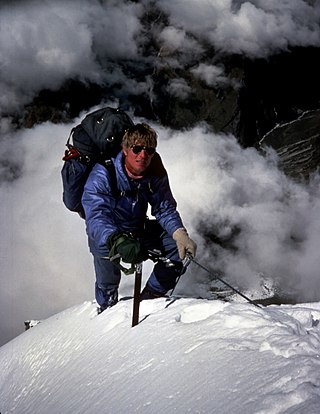
Scott Eugene Fischer was an American mountaineer and mountain guide. He was renowned for ascending the world's highest mountains without supplemental oxygen. Fischer and Wally Berg were the first Americans to summit Lhotse, the world's fourth highest peak. Fischer, Charley Mace, and Ed Viesturs summitted K2 without supplemental oxygen. Fischer first climbed Mount Everest in 1994 and later died during the 1996 blizzard on Everest while descending from the peak.
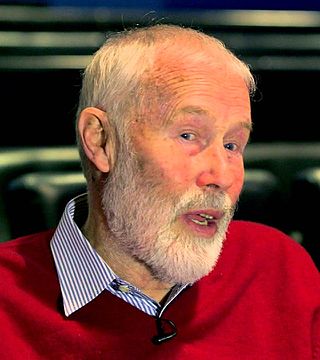
Sir Christian John Storey Bonington, CVO, CBE, DL is a British mountaineer.
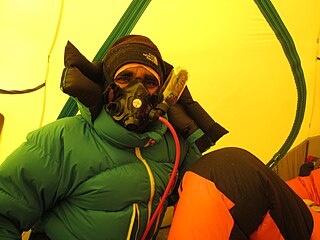
Expedition climbing, is a type of mountaineering that uses a series of well-stocked camps on the mountain leading to the summit, that are supplied by teams of mountain porters. In addition, expedition climbing can also employ multiple 'climbing teams' to work on the climbing route—not all of whom are expected to make the summit—and allows the use of supports such as fixed ropes, aluminum ladders, supplementary oxygen, and sherpa climbers. By its nature, expedition climbing often requires weeks to complete a given climbing route, and months of pre-planning given the greater scale of people and equipment that need to be coordinated for the climb.

Garrett Madison is an American mountaineer, guide and expedition leader. Madison began guiding professionally in 1999 on Mount Rainier and has climbed Mount Everest 14 times. His company, Madison Mountaineering, specializes in climbs on Mount Everest and other high altitude peaks, operates on the highest peaks on all seven continents, and also provides training programs and summit climbs in Washington State.
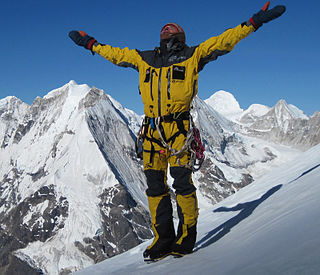
Martin Walter Schmidt, known as Marty, was a New Zealand-American mountaineer, guide and adventurer.

Richard "Rick" Agnew is an Australian alpine mountaineer and high altitude sports aviator who has completed the Seven Summits climbing Mount Everest and many other peaks. He holds over 40 international and Australian speed, distance and height aviation records.
Richard Frank "Rick" Allen was a Scottish mountaineer. Allen summitted six eight-thousanders and was the first British climber atop some of Tajikistan's biggest mountains. He had over 40 years experience climbing in the Himalayas at the time of his death.
















